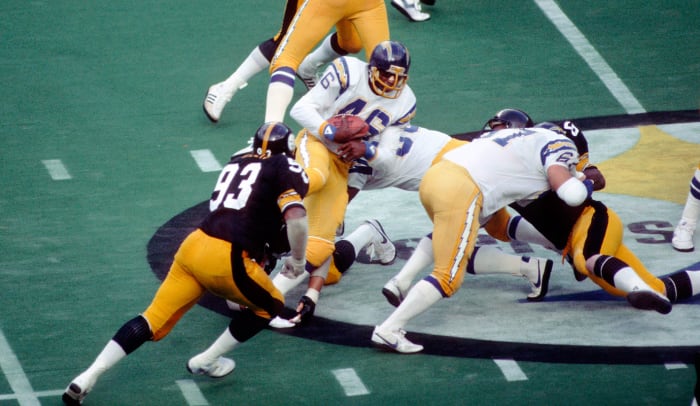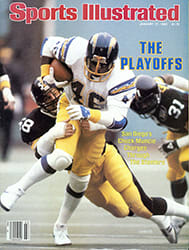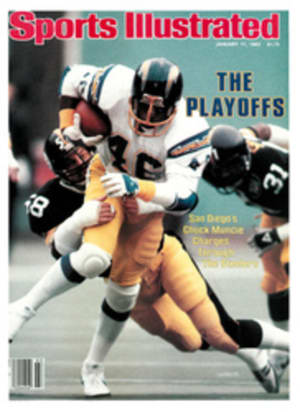San Diego Wouldn't Break
It was time to lay to rest some myths about the San Diego Chargers after they came from 11 points down in the fourth quarter to beat the Pittsburgh Steelers 31-28 in the first round of the AFC playoffs Sunday.
Myth No. 1: The Chargers can't play in cold weather. This one was born after the Cincinnati Bengals beat them last year in the AFC title match during which the wind-chill factor hit minus 59. Well, the temperature was 33° in Three Rivers Stadium Sunday, not an Ice Bowl, certainly, but chilly enough. The day was cold, the Chargers were hot.
Myth No. 2: San Diego Quarterback Dan Fouts will fold under pressure. Forget it. The former Fouts, maybe, but not the Fouts of the last few years. "When he's being blitzed he hangs in there," Steeler Middle Linebacker Jack Lambert said Sunday. "He takes his beating and he doesn't flinch. He's an old-fashioned quarterback, like Bobby Layne. He's not pretty—he looks like he's going to fall down when he goes back to pass—but he gets the job done. He did a job on us today."
Myth No. 3: The Chargers can't run the ball. Oh yeah? Try this: Chuck Muncie sweep left, Chuck Muncie sweep right. On Sunday they outrushed the Steelers, No. 1 in the NFL against the run, 146 yards to 97, and on their winning drive, when they got the ball on their own 36 with 3:59 left, they ran five times out of eight plays. The drive added up to 31 yards rushing, 28 yards passing, plus five yards on a penalty. In fact it was the threat of a run that set up the touchdown play, a 12-yard screen pass to Tight End Kellen Winslow.
Myth No. 4 (this is the meanest of all): They lack character. "No matter how well we play or what we do or who we do it to, someone with a nasty pen will always get on our case," Winslow said. "Someone said it once, and then people decided they liked it and kept saying it. If they want to say we lack character, that we're sissies, let 'em. None of them have to line up and play us."
It should be noted that the Chargers reached the playoffs three years in a row by beating, respectively, Denver, Pittsburgh and Oakland—not exactly a soft trio—in the final game of the regular season. They got to the AFC title game last year by beating Miami in overtime in one of the half-dozen or so games that people call the greatest ever. And they're on their way to Round 2 against Miami this year because they beat the Steelers in Three Rivers. The last time the Steelers lost a playoff game at home was in 1972. You don't win here without character.
Now we're left with the most persistent knock: The Chargers can't play defense. This isn't a myth; it's a fact, and it's the reason why none of the defeated Steelers would pick San Diego as a potential Super Bowl champ. "The best offense in football," Lambert said. "But their defense? Well, maybe I shouldn't say anything."
The game, you see, had been shootout football, something the Steelers would have dearly loved to avoid. Pittsburgh had won its last two games with ground troops, rushing for 212 yards and then 261. "Steeler-style football," their defensive coordinator, Woody Widenhofer, said, "the best style." On Sunday against the Chargers Pittsburgh had to play tennis-style. You score on your possession, we score on ours, you hold service, we hold service. The team that breaks service, the team that actually stops a drive, has a big edge in the set.
The Chargers held service with a 91-yard drive for a field goal on their first possession. This was after James Brooks had fumbled the opening kickoff and given the Steelers a TD recovery in the end zone.
"What was your reaction to that?" Winslow was asked.
"Our reaction," he sniffed, "was to drive 91 yards."
But then the Steelers served another ace, mounting a 71-yard TD drive to take a 14-3 lead. Then San Diego held serve, with an 80-yard drive and a touchdown. Score, 14-10, your serve. The first service break went to San Diego. At 12:40 of the second period Pittsburgh was forced to punt, a rare occurrence in a game like this. (The Chargers would get off their first and only punt with 12 minutes left in the game. It's a wonder they didn't flub it: They haven't practiced the play much. In one stretch this year they'd punted only eight times in five games.)
The service breaks evened out when San Diego drove 84 yards and fumbled on the Steeler seven. Then Charger Bruce Laird intercepted Terry Bradshaw on the one-yard line and set up another long drive that ended with a TD and a 17-14 halftime lead for San Diego. The pattern was clearly set. Forget about trench warfare. This was going to be frontal assault all the way.
When the smoke cleared after the first half, this is what the San Diego offense had accomplished: It had scored on three of its four possessions, on drives of 91, 80 and 64 yards. The last one had started with 1:46 left, the Chargers getting off seven plays in only a minute and 18 seconds. The drive they didn't score on had been a mere 84 yards. San Diego's total offense in the first half had been 325 yards, and this hadn't been done against a Baltimore or a Cleveland. It had been against the Steelers in Three Rivers. Pittsburgh had sacked enemy passers 34 times this year, often using exotic and intricate blitzes, but they held back for most of the afternoon against Fouts. "Their receivers adjust to the blitz too well," said Lambert. "One missed tackle and it's curtains."
Fouts had been flawless in that first half and Wes Chandler had already rolled up 100 yards in receptions, but the Steelers were oiling a gun of their own for the second set. Terry Bradshaw, remember him? Most of his season had been spent in a blue funk. He'd sprained a shoulder against Seattle on Nov. 28. "I started side-arming the ball after that," he said. "I'd throw when my feet weren't set. Everything fell apart." The Steelers were shut out twice, something that hadn't happened to them since 1957, when a very young Earl Morrall was the quarterback and the offense was Hi-Did-dle-Diddle, Rogel Up the Middle. A month ago a member of the Steeler defense suggested that the offense just ought to get the ball over midfield and then try for a field goal—on first down.
But there is no tougher competitor than Bradshaw in money situations, and against San Diego he was getting time to throw and he found his groove. In the third quarter he got hot—unbelievably hot—throwing underneath the coverage, dumping the ball off to Franco Harris, who would finish with 11 catches, letting the big guy motor. Bradshaw served 11-for-11 in that third quarter and had a career-high 14 straight, counting the last moments of the first half.
"I was reading well, not throwing particularly well all the time," he said. "Sometimes the passes felt great, sometimes they were end over end. Everything I called—well, I could tell this guy wasn't going to be covered, that guy wasn't. It was one of those games where I just saw the whole works, when I was rolling."
By the beginning of the fourth quarter Bradshaw had surpassed 300 yards—for the first time in 23 games. The Chargers had the ball only once in the third quarter, a 45-yard drive that ended a yard short of a first down on the Steeler 14. Pittsburgh had possession twice, for two long TD drives of 74 and 86 yards. Now Pittsburgh was sitting on a 28-17 lead, and if it could stop San Diego—just two service breaks—it would be home.
The Chargers got nowhere on their first possession in the last quarter. They punted. The Steelers had the ball and their 11-point lead with 12 minutes left, and it was at this point that the game turned—for the last time. New balls, please.
Third-and-eight on the Pittsburgh 21, Bradshaw rolls right. Maybe he runs for a first down, maybe not. However, he sees Lynn Swann break clear for a moment across the field and decides to throw. The pass has nothing on it, and Cornerback Jeff Allen intercepts and takes it to the Steeler 29.
"Right to me," Allen said. "I couldn't believe it."
"God dawg!" Bradshaw said, grimacing at the memory. "I knew I should've run it. It's times like that when I wish I were a running back, a wide receiver, anything but a quarterback."
Five plays and one penalty and the Chargers had cut the lead to 28-24, the payoff coming on a quick slant and then turnback pattern to Winslow, between the clutches of Lambert and Jack Ham. Fouts was cool: The pass came on fourth-and-six. "Jack tipped the ball," Lambert said. "A few inches either way and we'd have had it."
There was 8:31 left when the Steelers got the ball again, on their own 17. They tried to grind it out, eat the clock, keep possession. Steeler football, Three Rivers football. But the eras have changed. You don't try to stop the Chargers, you have to try to outscore them. Pittsburgh needed a touchdown to put the game away. What it ended up with was a third-and-seven on its own 44, and then a low pass to Tight End Bennie Cunningham—he swore he caught it, the official said no—and then a shanked 20-yard punt. Fouts had the ball on his own 36 with 3:59 to go. The match was on his racket.
"We just wanted to make yards," Fouts said. "Pass or run, it didn't matter. Muncie had been awesome, coming around the corner. We figured, let them try to stop him."
Muncie already had carried the ball 20 times en route to his third straight game of more than 120 yards rushing. (His final stats: 25 carries, 126 yards.) "I was pretty exhausted," he said. "I had to come in and lay down for 20 minutes after the game. But I looked at those guys in the huddle, Doug Wilkerson, Ed White, Dan, all those great old veterans, and they just nodded at me, and Charlie Joiner said, 'O.K., big back, start rolling.' "
Four Muncie carries for 33 yards, plus a 16-yard completion to Winslow, and a penalty, and San Diego had a second-and-five at the Steeler 10. Then Robin Cole, the Pittsburgh right linebacker, decided to take matters into his own hands. He blitzed. He guessed right, stopping Muncie for minus two. Third-and-seven. Charger time out. In the press box, Offensive Coordinator Larrye Weaver sent down a strange play—weak-side screen to Winslow, with Fouts doing a half-roll to his right and then throwing back across the field to his left.
"We'd completed it in the first half [for 18 yards]," Charger Coach Don Coryell said. "It's a play we've practiced every day for years, but we'd never called it in this situation, never in a goal-line situation. If a lineman doesn't rush or pursue Fouts, if a linebacker hangs back...things can go wrong. But the Steelers pursue well, they hustle. I remember thinking, 'God, what a great call.' "
Cole again blitzed on his own. He flew in like a bullet. But Fouts laid the ball behind him, and Winslow rumbled in for the score, overrunning Cornerback Mel Blount on the goal line. One minute left. The Steelers couldn't come back.
"It was Cover-One, my coverage," Cole said. "I tried to make a big play on my own. Sometimes you have to gamble. I guessed wrong. They picked a good time to call that play. The only way I could have stopped it would have been to jump 20 feet in the air."
"Do I think they'll win the Super Bowl? No, I don't," Bradshaw said afterward. "Their offense, yes. Their defense, no. But I'll tell you, if America gets in another war, I'll send San Diego out to run our offense. Air power, bombs, those big tanks on the line. Who'd stop them?
"I don't remember the last time I was in a game like this. At one time I looked up on the scoreboard and saw my stats and I thought it was a mistake.
"But if the Chargers do get in the Super Bowl, look out NFC. I'd like to see 'em in it, just to watch them. They sure are pretty, aren't they?"
PHOTO
With 1:07 to go, Winslow ran through Blount to score the winning touchdown on a screen pass from Fouts.
PHOTO
A superb passing day for anyone else—333 yards—was merely routine for Fouts.
PHOTO
Winslow looked the ball into his hands for his first TD.
PHOTO
At the half, Chandler led all the receivers with seven catches and an even 100 yards.
PHOTO
The Steelers exulted after Guy Ruff (hidden by 23) scored a TD by pulling in a fumble by Brooks (21) of the opening kickoff.
PHOTO
Cunningham says he held on—with his thighs if not hands—but it was ruled a trap.
PHOTO
Stallworth's eight catches, including this one-armed handstand job, made 116 yards.


